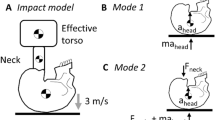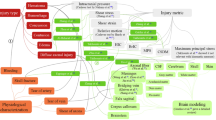Abstract
The effect of head mass on its biomechanical response during lateral impact to the head is investigated in this computational study. The mass of the head of a state-of-the-art validated finite element head model is altered by ±10 % from the base value of 4.7 kg. Numerical simulations of lateral head impacts for 30 cases (representing 15 human cadaver experiments × 2 mass configurations) are performed using the LS-DYNA solver at different velocities ranging from 2.4 to 6.5 m/s and three impacting conditions representing different stiffness and shapes of the contact/impact surfaces. Results are compared with the original model using the baseline head mass, thus resulting in a total of 45 simulations. Present findings show that the head mass has greater influence for peak interaction forces and the force has a greater dependency on stiffness of contact surface than the shape. Mass variations have also influence on skull strain energy. Regardless of increase/decrease in skull strain energy influenced by head mass variations used in the computational study, the 50 % fracture tolerance limit was unaltered, which was 544 mJ. The present study gives a better understanding of the mechanism of temporo-parietal skull impact.






Similar content being viewed by others
References
Allsop DL, Perl TR, Warner CY (1991) Force/deflection and fracture characteristics of the temporo-parietal region of the human head. Society of Automotive Engineering. SAE Paper No. 912907
Chatelin S, Deck C, Willinger R (2012) An anisotropic viscous hyperelastic constitutive law for brain material finite element modeling. J Biorheol. 1–12, ISSN 1867-0466. doi:10.1007/s12573-012-0055-6
Chen H, Luo Y (2010) Parametric study of closed head injuries. Adv Theor Appl Mech 3(7):339–347
Deck C, Nicolle S,Willinger R (2004) Human head FE modelling: improvement of skull geometry and brain constitutive laws. In: Proceedings on the IRCOBI conference, Graz, pp 79–92
Deck C, Willinger R (2008) Improved head injury criteria based on head FE model. Int J Crashworthiness 13(6):667–678
Deck C, Willinger R (2008b) Head injury prediction tool for predictive systems optimization. In: 7th European LS-DYNA conference
Gennarelli T, Pintar F, Yoganandan N, Beuse N, Morgan R (2002) Head injuries to nearside occupants in lateral impacts: epidemiological and full-scale crash test analyses. In: Proceedings of the IRCOBI. Munich, Germany, pp 223–233
Hardy WN, Foster CD, Mason MJ, Yang KH, King AI, Tashman S (2001) Investigation of head injury mechanisms using neutral density technology and high-speed biplanar X-ray. Stapp Car Crash J 45:337–368
Hardy WN, Mason MJ, Foster CD, Shah CS, Kopacz JM, Yang KH, King AI, Bishop J, Bey M, Anderst W, Tashman S (2007) A study of the response of the human cadaver head to impact. Stapp Car Crash J 51:17–80
Horgan TJ, Gilchrist MD (2003) The creation of three-dimensional finite element models for simulating head impact biomechanics. Int J Crashworthiness 8(4):353–366
Kang HS, Willinger R, Diaw BM, Chinn B (1997) Validation of a 3D human head model and replication of head impact in motorcycle accident by finite element modeling. In: Proceeding of 41th Stapp Car Crash Conference, Society of Automotive Engineers, Lake Buena Vista, USA, pp 329–338
Kleiven S, von Holst H (2002) Consequences of head size following trauma to the human head. J Biomech 35(2):153–160
Kleiven S (2003) Influence of impact direction to the human head in prediction of subdural hematoma. J Neurotrauma 20(4):365–379
Nahum A, Smith R, Ward C (1977) Intracranial pressure dynamics during head impact. In: Proceeding of 21st Stapp Car Crash Conference, SAE Paper No. 770922
NHTSA (2002) Code of federal regulations, Title 49, Part 571. National highway traffic safety administration, federal motor vehicle safety standards, Washington, DC
Pintar FA, Yoganandan N, Baisden J (2005) Characterizing occipital condyle loads under high-speed head rotation. Stapp Car Crash J 49:33–47
Pintar FA, Maiman DJ, Yoganandan N (2007) Injury patterns in side pole crashes. Annu Proc Assoc Adv Automot Med 51:419–433
Raymond D, Van Ee C, Crawford G, Bir C (2009) Tolerance of the skull to blunt ballistic temporo-parietal impact. J Biomech 42(15):2479–2485
Ruan JS, Khalil T, King AI (1993) Finite element modeling of direct head impact. In: Proceedings of 37th Stapp Car Crash Conference, SAE Paper No. 933114, San Antonio, TX
Ruan J, Prasad P (2001) The effects of skull thickness variations on human head dynamic impact responses. Stapp Car Crash J 45:395–414
Sahoo D, Deck C, Willinger R (2013) Development and validation of an advanced anisotropic visco-hyperelastic human brain FE model. JMBBM. doi:10.1016/j.jmbbm.2013.08.022
Sahoo D, Deck C, Yoganandan N, Willinger R (2013) Anisotropic composite human skull model and skull fracture validation against temporo-parietal skull fracture. JMBBM 28:340–353
Sarron JC, Caillou JP, Da Cunha J, Allain JC, Tramecon A (2000) Consequences of nonpenetrating projectile impact on a protected head: study of rear effects of protections. J Trauma 49(5):923–929
Tagliaferri F, Compagnone C, Yoganandan N, Gennarelli TA (2009) Traumatic brain injury after frontal crashes: relationship with body mass index. J Trauma 66(3):727–729
Trosseille X, Tarriere C, Lavaste F, Guillon F, Domont A (1992) Development of a F.E.M. of the human head according to a specific test protocol. In: Proceedings of 36th Stapp Car Crash Conference, SAE Paper No. 922527
Tsai SW, Wu EM (1971) A general theory of strength for anisotropic materials. J Compos Mater 5:58–80
Willinger R, Baumgartner D (2003) Human head tolerance limits to specific injury mechanisms. Int J Crashworthiness 8(6):605–617
Yoganandan N, Pintar FA (2004) Biomechanics of temporo-parietal fracture. Clin Biomech 19:225–239
Yoganandan N, Gennarelli TA, Zhang J, Pintar FA, Takhounts E, Ridella SA (2009) Association of contact loading in diffuse axonal injuries from motor vehicle crashes. J Trauma 66:309–315
Yoganandan N, Maiman DJ, Guan Y, Pintar F (2009) Importance of physical properties of the human head on head–neck injury metrics. Traffic Injury Prev 10:488–496
Yoganandan N, Pintar FA, Zhang J, Baisden JL (2009) Physical properties of the human head: mass, center of gravity and moment of inertia. J Biomech 42:1177–1192
Yoganandan N, Baisden JL, Maiman DJ, Gennarelli TA, Guan Y, Pintar FA, Laud P, Ridella SA (2010) Severe-to-fatal head injuries in motor vehicle impacts. Accid Anal Prev 42(4):1370–1378
Yoganandan N, Stemper BD, Pintar FA, Maiman DJ (2011) Use of postmortem human subjects to describe injury responses and tolerances. Clin Anat 24:282–293
Zhang J, Yoganandan N, Pintar FA, Gennarelli TA (2006) Brain strains in vehicle impact tests. Annu Proc Assoc Adv Automot Med 50:1–12
Zhang J, Yoganandan N, Pintar FA (2009) Dynamic biomechanics of the human head in lateral impacts. Annu Proc Assoc Adv Automot Med 53:249–256
Acknowledgments
The authors acknowledge the ANR-12-EMMA-0026-0 (SUFEHM-13) and VA medical research for their research support to this work.
Author information
Authors and Affiliations
Corresponding author
Rights and permissions
About this article
Cite this article
Sahoo, D., Deck, C., Yoganandan, N. et al. Influence of head mass on temporo-parietal skull impact using finite element modeling. Med Biol Eng Comput 53, 869–878 (2015). https://doi.org/10.1007/s11517-015-1295-6
Received:
Accepted:
Published:
Issue Date:
DOI: https://doi.org/10.1007/s11517-015-1295-6




